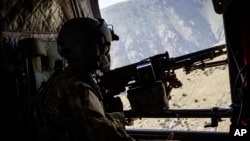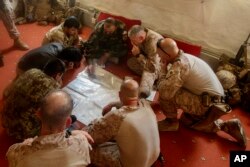The Pentagon said Friday that the defense secretary has not yet decided how many U.S. troops to commit to the fight in Afghanistan.
Defense Secretary James Mattis "has made no decisions on a troop increase for Afghanistan,” wrote Pentagon spokeswoman Dana White. “As he said throughout the week in testimony, the revised Afghanistan strategy will be presented to the president for his approval in the coming weeks.”
White’s statement Friday was in response to a story by The Associated Press, quoting an unnamed Trump administration official as saying the Pentagon would send 4,000 additional American forces to Afghanistan.
That number is similar to previous reports from other U.S. officials, who have told VOA that the secretary and his commander on the ground are looking at deploying between 3,000 and 5,000 additional American troops to assist the South Asian nation in its fight against the Taliban insurgency.
Those U.S. officials explain that the new Afghanistan strategy would require a total of about 5,000 additional international forces in the war-torn country. Nearly all are expected to be Americans, with several hundred additional troops from coalition allies.
The AP report said Mattis could make the announcement about deploying the troops as early as next week. The Pentagon did not explicitly deny that a troop number announcement was in the works, saying only that “any decisions about troop numbers will be made only after consultation with the interagency, the Afghan government, NATO allies and coalition partners.”
U.S. President Donald Trump gave Mattis the authority to set troop levels in Afghanistan on Tuesday, according to the defense secretary.
Mattis told the Senate Armed Services Committee on Tuesday that the U.S. was not gaining in the fight to stabilize Afghanistan, and he vowed to present a strategy to Congress "by mid-July."
'Not winning'
The additional troops are seen as important for a mission that top commanders admit is not succeeding.
"We are not winning in Afghanistan right now, and we will correct this as soon possible," Mattis said.
Mattis equated "winning" in Afghanistan with the Afghan government's ability to handle the enemy's level of violence, which he said would require a "residual force" of U.S. and allied forces to train Afghan troops and maintain high-end capabilities.
Afghan analyst Andrew Wilder at the U.S. Institute of Peace said it was unclear whether sending an additional 4,000 U.S. troops to Afghanistan would be effective in turning back the insurgency.
Instead, he said, the U.S. should better define its overall strategy with specific objectives.
Wilder added that the U.S. should remain focused to keep Afghanistan from becoming a safe haven for terrorist groups.
Mattis has said the U.S. cannot quit Afghanistan, because that would allow the rise of "ungoverned spaces" in the country, which could be exploited by groups that threaten the United States.
But Republican Senator John McCain of Arizona, the chair of the Armed Services Committee, stressed that Congress needed to see more of a plan about how the U.S. would move forward in Afghanistan.
"We want a strategy, and I don’t think that’s a hell of a lot to ask,” McCain said Tuesday.








